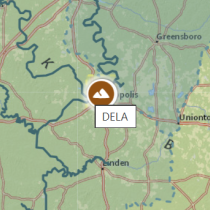Data Notification
DNA Barcoding Approach Updated – Focus on Taxonomic Confirmations Rather than Genetic Diversity
November 5, 2025
NEON disseminated a survey in 2023 to gather community feedback on the DNA barcoding data products for beetles (DP1.10020.001), fish (DP1.20105.001), small mammals (DP1.10076.001), and mosquitoes (DP1.10038.001). Responses were received from twelve community members indicating that taxonomic quality checks were the highest priority for these data products, followed by characterization of genetic diversity. In response to the survey results, NEON scientists performed an evaluation of the utility of the DNA barcode data products for taxonomic quality checks and genetic diversity research.
To assess the DNA barcoding taxonomic outputs, each NEON sample was assigned a genetically-determined taxonomic identification using multiple competing methodologies available from the Barcode of Life Datasystems (BOLD). These methodologies included using the top genetic matches in the BOLD database, as well as the majority taxonomic identification in the corresponding BOLD Barcode Index Number (BIN) grouping.
NEON developed an algorithm to assess the reliability and repeatability of the genetically-determined taxonomic identification methods for each species with a NEON sample that has been submitted to BOLD. The results of this analysis included: i) a list of high-priority taxa for DNA barcoding due to high rates of mismatch between the NEON morphological identification and reliable BOLD genetic identification, and ii) a list of taxa for which additional positive-control samples should be submitted to BOLD to enhance the quality of genetic identifications available in the database.
NEON conducted an additional analysis of the accumulation of new genetic variants relative to the number of sequences of each taxon that has been submitted to BOLD. This work indicated that the genetic diversity of the COI gene for the species that have been submitted by NEON for DNA barcoding is well characterized, such that value of additional diversity-focused sequencing is declining. This is due in part to the fact that the COI gene is relatively conserved within a given species, which is what makes it particularly useful for taxonomic identifications, but less useful for genetic diversity studies.
Beginning this winter, a subset of mosquito, beetle, fish and mammal samples collected in 2024 (and beyond) will be selected for sequencing of the COI gene with a focus on confirmation of challenging taxonomic identifications. Additional ‘positive control’ samples will be sent for sequencing from species that are poorly represented on BOLD and that would be useful for taxonomic confirmation purposes. The sample sizes for each taxonomic group used to generate these products are also changing, with a significant decrease in the sample sizes for beetles and mosquitoes and a significant increase in the sample size for small mammals. These altered sample sizes reflect that the beetle and mosquito taxonomic groups are generally well characterized by our contracted professional taxonomists, while Peromyscus small mammal species are commonly known to be difficult to distinguish in the field.
The change from Sangar to PacBio sequencing reflects the reduced costs and high data quality of the latter. The sequencing data and associated taxonomic identifications will continue to be served via BOLD, with the first PacBio-generated data expected to be published in Spring 2026.
Concomitant with this change in design, NEON scientists will begin reviewing the results annually to update taxonomic identifications in the associated data products for those individuals for which BOLD data strongly support a change. All taxonomic updates will be recorded in existing identificationHistory tables for each data product along with the rationale for the taxonomic update.
Please use the Contact Us form for further inquiries; please include the term "DNA barcoding updates" in the body of your request.
